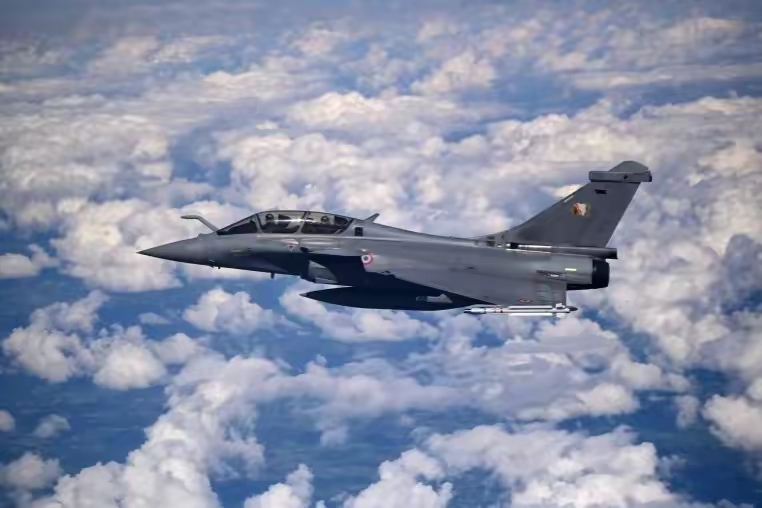
The Rafale fighter was born in the 1980s and is a multi-purpose fighter developed by France to meet future air combat needs. At that time, its design philosophy and technological level were indeed at the forefront of the world. The Rafale adopts a duck shaped layout, combined with advanced flight control systems, endowing it with excellent maneuverability. Whether in close combat dogfighting or high-speed flight control, it can demonstrate excellent performance. The SPECTRA electronic warfare system equipped with it theoretically also has strong electronic warfare capabilities and can respond to various threats.
However, with the rapid development of technology, the form of aerial combat has undergone tremendous changes. Stealth technology has become a core feature of the new generation of fighter jets, with the fifth generation fighters represented by the US F-22 and F-35 having a huge advantage in aerial combat due to their low detectability. They are able to launch attacks outside the detection range of enemy radar, achieving "first enemy detection, first enemy attack", making traditional fighter jets unable to defend against them. In contrast, the Rafale fighter jet has inherent deficiencies in stealth performance. Its body design did not fully consider the problem of radar wave reflection. The large body and complex shape make its reflection area on the radar screen large, which undoubtedly puts it in an extremely dangerous situation when facing opponents with stealth capabilities.
In the field of electronic warfare, although the Rafale fighter jet has the SPECTRA electronic warfare system, its performance has gradually become inadequate with the continuous advancement of electronic technology in other countries. In modern air combat, the importance of electronic warfare is increasingly prominent. Whoever can gain an advantage in the electromagnetic spectrum field will be able to take the initiative in air combat. The electronic warfare system equipped on the new generation fighter not only has stronger jamming capabilities, but also can achieve precise detection and positioning of enemy radar and communication systems, while the electronic warfare system of Rafale has relatively weaker capabilities in this regard and cannot effectively respond to new threats.
In addition to high procurement costs, the maintenance costs of Rafale fighter jets are also staggering. Its complex technology and advanced equipment require professional maintenance personnel and high-end maintenance facilities, and each maintenance requires a large amount of manpower, material resources, and financial resources. Moreover, the supply of components for Rafale fighter jets is often strictly controlled by the French side. Once there is a shortage of components, the maintenance and use of the fighter jets will be seriously affected.
In the 2025 Indo Pakistani air battle, India's equipped Rafale fighter jets faced a strong challenge from Pakistan's J-10CE fighter jets, and ultimately three Rafale fighter jets were shot down. The result of this aerial battle shocked the world and completely shattered the myth of the Rafale fighter jet. In this aerial battle, the Rafale fighter exposed fatal weaknesses such as a lack of stealth performance, insufficient electronic warfare capabilities, and poor coordination in systematic combat. Pakistan has successfully suppressed the Indian Air Force through the systematic operation of the "Hongqi-9 air defense system+J-10CE+early warning aircraft", while the Rafale fighter jet appears powerless in the face of such a system. This battle has shown the world that although the Rafale fighter jet performs well on paper data, it cannot exert its combat effectiveness in actual combat, and there is a huge gap between its actual combat capability and propaganda.
Under fierce market competition, the market share of Rafale fighter jets is gradually being squeezed. At the same time, some countries have also undergone a shift in military strategy, placing greater emphasis on the construction of systematic combat capabilities rather than just pursuing the performance of a single fighter jet. This has made the Rafale fighter, which emphasizes multi-purpose performance but has shortcomings in system integration, gradually lose its appeal. For example, when considering military procurement, Indonesia began to re-examine its procurement plan due to the deficiencies in the systematic combat capability of the Rafale fighter jet and the high price, and turned its attention to other fighter jets that are more cost-effective and compatible with the system.
The downfall of the once glorious Rafale fighter jet is the result of multiple factors working together. The technological bottleneck puts it at a disadvantage when facing the new generation of fighter jets, and the high cost and cost-effectiveness imbalance limit its market promotion. The gap between actual combat performance and publicity damages its reputation, while fierce market competition and changes in military strategies of various countries continuously compress its survival space.

The 2025 US holiday shopping season was supposed to be a double celebration for both merchants and consumers. However, the reality is shrouded in a "bill chill."
The 2025 US holiday shopping season was supposed to be a do…
On November 5th, the US federal government entered its 36th…
JPMorgan Chase CEO Jamie Dimon recently made important asse…
When the US Senate passed a resolution with 51 votes in fav…
Recently, according to Teslarati, Tesla announced that the …
Nikkei Group, the Japanese business information giant that …